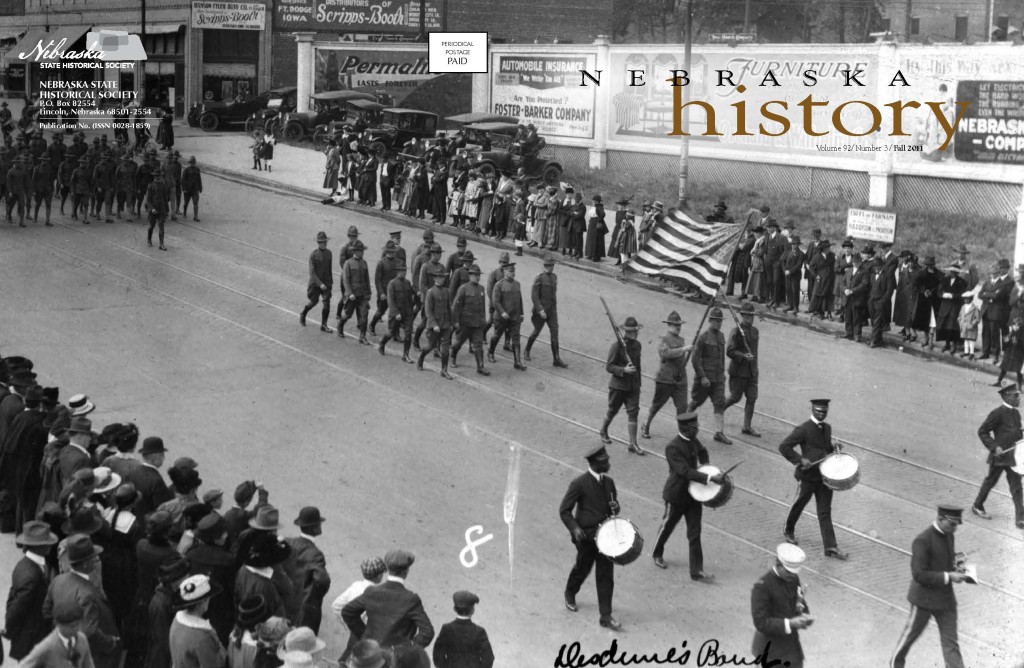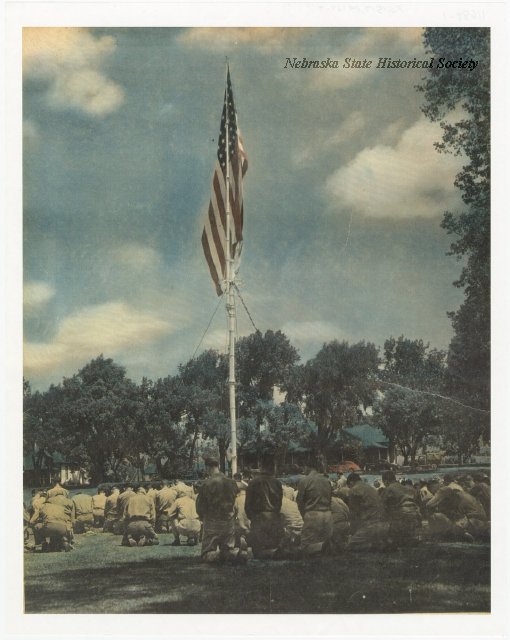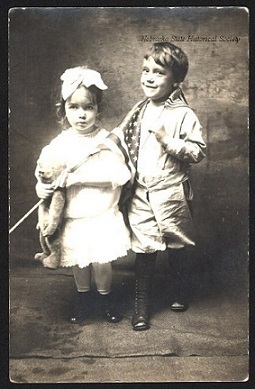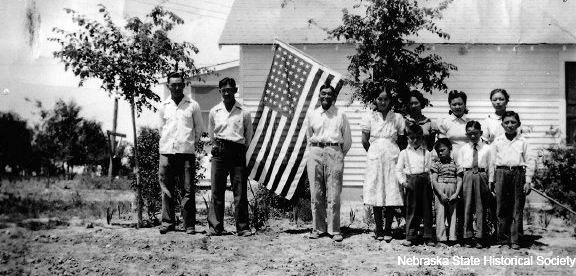
By Kylie Kinley, Assistant Editor (April 2016)
“Shame on the men on the cover Vol. 92 No. 3. No one except the man on the back cover, middle bottom, front row is removing his cap as the flag goes by.” A reader submitted this comment after seeing the Fall 2011 edition of Nebraska History, which depicts the Dan Desdunes Band marching in an Omaha parade in the late 1910s or early 1920s. Though the color guard carries the flag, none of the spectators – male or female – have removed their hats. How could these men and women be so unpatriotic? The United States had just finished World War I, and the men who carried the flag were likely veterans. But if the man in the front row is indeed removing his cap (he also might be scratching his head; the photo just shows him with his hand on the bill of his cap), he was ahead of his time.

A number of soldiers kneeling at an American flag on the parade grounds at Fort Robinson just after World War II. Fort Robinson, Nebraska, 1945. RG1517.PH000067-000009
Flag Code History
According to a Congressional Research Service report, the National Flag Conference adopted the National Flag Code on June 14, 1923. June 14 commemorates the day the U.S. adopted the Stars and Stripes as its official flag in 1777, and had been celebrated as Flag Day since President Woodrow Wilson issued a proclamation in 1916 (Library of Congress). Americans further elevated the flag when President Herbert Hoover signed a congressional act into law on March 3, 1931 that made “The Star-Spangled Banner” the national anthem (History.com).
Congress made the flag code into law in 1942 and established National Flag Day in 1949. The flag code serves as the guide for all handling and display of the flag, but it does not impose penalties for the misuse of the flag (CRS Report). According to the flag code, “When not in uniform men should remove their headdress with their right hand and hold it at the left shoulder, the hand being over the heart. Persons in uniform should remain silent, face the flag, and render the military salute” (Smithsonian). The flag code doesn’t discuss hat behavior for women. But manners expert Emily Post dictates that fashion hats can be left on when saluting the flag because they are usually pinned on and difficult to remove. Women do need to remove unisex hats or ball caps (Emily Post Institute).
Why We Salute the Flag
The origin of the hand-to-forehead salute isn’t clear, but the U.S. Marines Corps’ website discusses several possibilities. In medieval days, mounted, armored knights raised their visors to identify themselves when meeting friends. Another explanation is that when assassinations by dagger were common, people approached each other with their hands raised, palm to the front, to display that they held no concealed weapon. The final – and most likely – explanation is that the hand salute evolved from the British navy because it was the first part of how sailors uncovered their heads in front of a senior.

A studio portrait of Lucile Gray Whaley & Fred Remington Whaley. They’re each holding an American flag and she holds a stuffed bear as well. Place unknown, 1912. RG0907.PH000001-000004
This gesture evolved into a sign of respect or trust, and men doffed their hats to greet friends or guests, particularly women. Americans in the mid-1920s transferred those emotions to their flag. The American flag is referred to as female, and they saluted to demonstrate trust and respect for the authority behind the flag. The evolution of the current hand-over-heart salute is much easier to trace. The Smithsonian’s American History blog says how before the 1940s, American school children saluted with a gesture that is now a symbol of fascism. Children used to salute the flag by placing their right hands to their foreheads and then extending their right hands out toward the flag. They didn’t say “Heil, Hitler,” of course, but this salute too closely resembled the Nazi one-armed salute, so it was replaced in 1942 with the practice of placing the right hand over the heart.
Flag Traditions and Beliefs

This is the Monument to Red Cloud and the Black Hills Treaty of 1876 in Crawford, Nebraska. October 27, 1917. RG2063.PH000035-000024
Flag protocol is different for military members and civilians and has responded to national and international influences, but its importance to our country is significant enough that everyone from the U.S. government to Emily Post has created flag etiquette rules. Respecting the flag isn’t just about patriotism; Miss Post bothering to create guidelines means that these rules also have an impact on our social psyche. The custom of removing hats isn’t just about showing respect for the flag. It’s about American traditions and beliefs about showing the backs of our heads in public. Considering recent controversy about religious garments, it’s interesting to look at photos such as the ones we publish in Nebraska History and see past head-covering customs even if many of those rigid standards have lapsed.
Hats are still essential parts of work uniforms in America; indeed, they are a part of several occupations’ identities and safety standards. In Nebraska, you can often guess the part of the state people are from by their hats – whether they’re flat bills, curved bills, or cowboy hats. Covering our heads is respectful in some circumstances (several religions require worshipers wear a head covering in worship centers) but disrespectful in others (Miss Post says you shouldn’t wear your hat while you eat). We want our God to see our heads only sometimes, but we want our flag to see our heads always. However, refusing to salute the flag has been protected as a form of free speech since 1942, as is burning and desecrating the flag, which the Supreme Court ruled as free speech in 1989 and 1990 (Smithsonian).
Generally, Americans love the flag. We put American flags on beef jerky wrappers we use to wipe the salt and gristle off our fingers in lieu of a napkin and throw it away. Or we grab a flag-bedecked napkin, then throw that away. We put them on bikinis and swim trunks and beer cans. We wrap American flags around naked women and photograph them. Then, if you’re like my high school history teacher, you display that picture right behind your desk so it’s at eye-level with your students when they come to ask you a question. All of this is explicitly forbidden by the U.S. Flag Code, which says the flag should never be used as a costume or athletic uniform (and American flag bikinis are neither). The code also forbids flags to be “printed or otherwise impressed on paper napkins or boxes or anything that is designed for temporary use and discard” and the flag “should never be used as a receptacle for receiving, holding, carrying, or delivering anything” (including holding beer and naked women). While the code is really only a set of guidelines, flags and what they mean to us can strike deep emotional chords – just consider the Confederate flag controversy of last summer. We care so much about our flag that we have a code to govern how we behave around it. But then we care so little that the code does not apply to flags on material goods like bug spray, pizza boxes, lawn chairs, or food. Or, you could argue that we value the Stars and Stripes so much that we don’t want it to be on a pole or a pedestal, but with us in our everyday lives – bedecking our shirts and sheets and wiping our lips.
The dress code has relaxed considerably in our country, and the hat is no longer considered an essential part of Americans’ leaving-the-house wardrobe. Even more remarkable, then, is our communal act of removing our hats when the flag passes by us. This rule was not practiced for the first 150 years of the United States’ existence, but it has survived 80 years of cultural upheavals about what patriotism means for Americans. Whether it’s covering a casket of a fallen soldier, wrapped around the shoulders of an Olympic athlete, flying from the top of a skyscraper in New York, or hanging from a windmill in Nebraska, we salute it. With our hands and our hearts and, generally, without our hats.

An exterior portrait of the Sakurada family in front of an American flag. From left: Yukio, Masami, Tokuzo, Endo, Kazuye, Miyeko and Hisaye. Front row: Leonard, Fred, Ken and Neil. Scotts Bluff County, Nebraska, c. 1940. RG5922.PH0-000032

This photo is from the Omaha Indians collection. It shows the casket containing the body of Henry Robinson. Standing behind the casket are front row: John G. Miller, Walter Hamilton, James Hamilton, Henry F. Grant, Wallace Tyndall, Sam Thomas; back row: Lee Gilpin, Charles Wolfe; Frank M. Grant and John Robinson. Bancroft, Nebraska, c. 1920. RG1289.PH000026-000008
Sources
Emily Post Institute. “Flag Etiquette.” Advice. N.d. Web. Accessed 8 April 2016. http://emilypost.com/advice/flag-etiquette/
History.com. “The Star-Spangled Banner” becomes official.” A&E Television Networks. N.d. Web. http://www.history.com/this-day-in-history/the-star-spangled-banner-becomes-official
Library of Congress. “Flag Day Celebrated June 14, 1777.” America’s Library. N.d. Web. Accessed 8 April 2016. http://www.americaslibrary.gov/jb/modern/jb_modern_birth_1.html
Luckey, John R. “The United States Flag: Federal Law Relating to Display and Associated Questions.” Congressional Research Division. 14 April 2008. Web. Accessed 8 April 2016. http://www.senate.gov/reference/resources/pdf/RL30243.pdf
Smithsonian. “Pointers from the Flag Code, just in time for Flag Day.” American Story. 10 Jun. 2014. Web. Accessed 8 April 2016. http://americanhistory.si.edu/blog/2014/06/pointers-from-the-flag-code-just-in-time-for-flag-day.html
United States Marine Corps History Division. “Customs and Traditions: Military Salute.” Official U.S. Marine Corps Web Site. N.d. Web. https://www.usmcu.edu/Research/Marine-Corps-History-Division/Brief-Histories/Military-Salutes/



